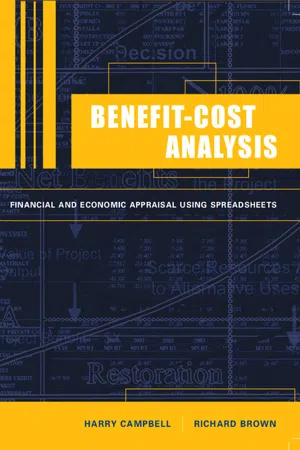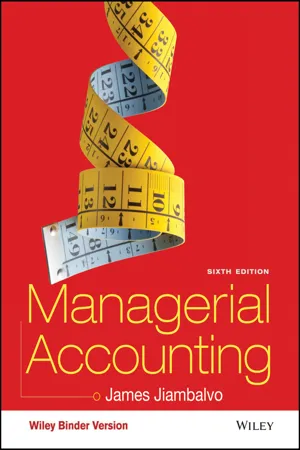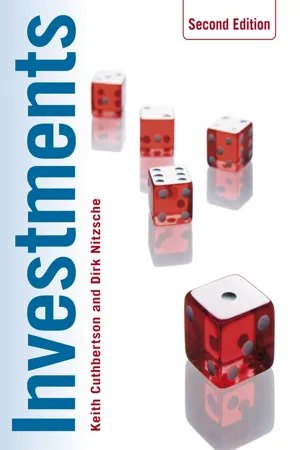Business
NPV Investment Decision Rule
The NPV (Net Present Value) investment decision rule is a financial metric used to evaluate the profitability of an investment. It compares the present value of expected cash flows from an investment to the initial cost of the investment. If the NPV is positive, the investment is considered financially viable, while a negative NPV suggests the investment may not be worthwhile.
Written by Perlego with AI-assistance
Related key terms
1 of 5
12 Key excerpts on "NPV Investment Decision Rule"
- eBook - PDF
Benefit-Cost Analysis
Financial and Economic Appraisal using Spreadsheets
- Harry F. Campbell, Richard P. C. Brown(Authors)
- 2003(Publication Date)
- Cambridge University Press(Publisher)
Among these decision-rules the most well known are the net present value (NPV) criterion, the internal rate of return (IRR), and benefit/cost ratio (BCR). In the sections that follow we shall examine each of these criteria and their use-fulness in the different project decision-making situations. The Net Present Value (NPV) Criterion The NPV of a project simply expresses the difference between the discounted present value of future benefits and the discounted present value of future costs: NPV = PV (Benefits) – PV (Costs). A positive NPV value for a given project tells us that the project benefits are greater than its costs, and vice versa . When we compare the project’s total discounted costs and dis-counted benefits, we derive the NPV: Example 3.4: Comparison of Projects A and B using Net Present Value Project A: Year 0 1 2 3 (1) Cash Flow –100 +50 +40 +30 (2) Discount Factor (at 10%) 1.00 0.909 0.826 0.751 (3) Discounted cash flow (=1x2) –100.00 45.45 33.04 22.53 NPV(A) 0.1 = –$100(1.0) + $50(0.909) + $40(0.826) + $30(0.751) = $101.02 – 100.00 = $1.02 As NPV(A) > 0, accept the project (when cost of capital = 10%). Investment Appraisal: Decision-Rules 41 Project B: Year 0 1 2 3 (1) Cash Flow –100 +30 +45 +50 (2) Discount Factor (at 10%) 1.00 0.909 0.826 0.751 (3) Discounted cash flow (=1x2) –100.00 45.45 33.04 22.53 NPV(B) 0.1 = –$100(1.0) + $30(0.909) + $45(0.826) + $50(0.751) = –$100.00 + $27.27 + $37.17 + $37.55 = $101.99 – $100 = $1.99 As NPV(B) is positive, project B can also be accepted. Which project is preferred: A or B? As NPV(B) > NPV(A), B would be preferred to A (at 10% discount rate). The Effect of Changing the Discount Rate We have been assuming a 10% discount rate so far. - eBook - PDF
- Robert Parrino, David S. Kidwell, Thomas Bates, Stuart L. Gillan(Authors)
- 2021(Publication Date)
- Wiley(Publisher)
10.2 Net Present Value 10-13 Concluding Comments on NPV Some concluding comments about the NPV method are in order. First, as you may have noticed, the NPV computations are rather mechanical once we have estimated the cash flows and the cost of capital. The real difficulty is estimating or forecasting the future cash flows. Although this may seem to be a daunting task, managers with experience in producing and selling a particular type of product can usually generate fairly accurate estimates of sales vol- umes, prices, and production costs. Most business managers are routinely required to make decisions that involve expectations about future events. In fact, that is what business is really all about—dealing with uncertainty and making decisions that involve risk. Second, estimating project cash flows over a long forecast period requires skill and judgment. There is nothing wrong with using estimates to make business decisions as long as they are based on informed judgments and not guesses. Problems can arise with the cash flow estimates when a project team becomes overly enamored with a project. In wanting a particular project to succeed, a project team can be too optimistic about the cash flow projections. It is therefore very important that capital budgeting decisions be subject to ongoing and postaudit review. In conclusion, the NPV approach is the method we recommend for making capital investment decisions. It provides a direct (dollar) measure of how much a project will increase the value of the firm. NPV also makes it possible to correctly choose between mutually exclu- sive projects. The accompanying table summarizes NPV decision rules and the method’s key advantages and disadvantages. DECISION MAKING EXAMPLE 10.1 The IS Department’s Capital Projects Situation Suppose you are the manager of the information systems (IS) department of the frozen pizza manufacturer we have been discussing. - eBook - ePub
Making the Compelling Business Case
Decision-Making Techniques for Successful Business Growth
- W. Messner(Author)
- 2013(Publication Date)
- Palgrave Macmillan(Publisher)
5
Making Investment Decisions with NPV
The previous chapters have set out the basic model of a business case using the net present value (NPV) technique. While the model is simple and straightforward, it can very well manage to cope with all kinds of complexity that real-life investment decisions throw at the business case team. Yet NPV and the need for formal investment decision methods are frequently discussed in organizations. Approving new investments often means a change in the way an organization does business and runs its processes; change of any sort is always a challenge in an organization. But most managers who argue against formal investment decision methods are only criticizing the way in which these methods are applied, and rarely the underlying processes or methods themselves. In order to overcome such concerns, this chapter takes the introduction to NPV as provided in Section 2.2 a step further and highlights a few areas which require attention and consideration in practical business cases:What if cash flows do not occur once a year, but come in and leave the company continuously? (Section 5.1 )What method to use for estimating the terminal value of an investment at the end of the investment’s lifespan? (Section 5.2 )How to compare investments with different time horizons, i.e. which do not necessarily start and end at the same time or where the start time is an option? (Section 5.3 )How to deal with resource constraints? (Section 5.4 )If there is a risk of inflation, how does the NPV calculation need to be adjusted? (Section 5.5 )Theoretical considerations of NPV often make the method look more complex and complicated than necessary. This is not necessary, and Sections 5.6 and 5.7 - eBook - ePub
- Brümmer LM, Hall JH, Du Toit E(Authors)
- 2017(Publication Date)
- Van Schaik Publishers(Publisher)
16310The capital investment decision
Learning outcomes
After studying this chapter, you should- understand the net present value method
- know how to calculate the net present value, for both a single sum and an annuity
- know how to apply the net present value method when purchasing shares
- know how to calculate the internal rate of return
- be able to apply the internal rate of return
- be able to apply the payback period method
- be able to make prudent decisions in the investment of capital.
Capital budgeting techniques
There is an extension or modification of the time value of money concept called the net present value, abbreviated to NPV. This is a sophisticated technique, providing a method whereby investment projects that yield cash inflows into the future may be valued in the present, which deals in net monetary amounts. This technique, together with two others, namely the internal rate of return and the payback period method, will be the focus of this chapter.Examples on the Statement of Financial Position that would involve application of the NPV method would be the organisation’s purchase of fixed assets and an investor’s purchase of shares in an organisation. We shall discuss these examples when we come to the detailed discussion on capital budgeting techniques later in this chapter.In the context of this book, an investment project will refer principally to the investment of funds in the purchase of fixed assets and shares. Since nobody can afford to invest money at a loss, the net present value method is a means of determining whether or not an investment will be a profitable proposition.A second technique, the internal rate of return (IRR), is also considered a sophisticated one and is indirectly related to the NPV. As the name implies, it is 164 intended to provide a rate of return - eBook - PDF
- James Jiambalvo(Author)
- 2016(Publication Date)
- Wiley(Publisher)
Capital expenditure decisions are investment decisions involv- ing the acquisition of long-lived assets. A capital budget is the final list of approved acquisitions. Two of the primary methods for evaluating investment opportunities, which take into account the time value of money, are the net present value method (NPV) and the internal rate of return method (IRR). The net present value method equates all cash flows to their present values. If the sum of the present values of cash inflows and outflows (i.e., the NPV) is zero or positive, the return on the investment equals or exceeds the required return and the investment should be made. The internal rate of return method calculates the rate of return that equates the present value of the future cash flows to the initial investment. If this rate of return is equal to or greater than the required rate of return, the investment is warranted. LEARNING OBJECTIVE 2 Calculate the depreciation tax shield and evaluate long-run decisions, other than investment decisions, using time value of money techniques. In analyzing cash flows for a net present value analysis or an internal rate of return analysis, remember that depreciation is not a cash flow but the tax savings generated by depreciation are relevant to the analysis. The tax savings owing to depreciation are referred to as the depreciation tax shield. NPV and IRR are also used to evaluate long-run decisions that are not capital budgeting decisions. Examples include outsourcing decisions and decisions related to multiyear adver- tising campaigns. LEARNING OBJECTIVE 3 Use the payback period and the accounting rate of return methods to evaluate investment opportunities, and explain why managers may concentrate erroneously on the short-run profitability of investments rather than their net present values. The payback method evaluates capital projects in terms of how quickly the initial investment is recovered by future cash inflows. - eBook - PDF
- James Jiambalvo(Author)
- 2019(Publication Date)
- Wiley(Publisher)
Capital expenditure decisions are investment decisions involving the acquisition of long-lived assets. A capital budget is the final list of approved acquisitions. Two of the primary methods for evaluating investment opportu- nities, which take into account the time value of money, are the net present value method (NPV) and the internal rate of return method (IRR). The net present value method equates all cash flows to their present values. If the sum of the present values of cash inflows and outflows (i.e., the NPV) is zero or positive, the return on the invest- ment equals or exceeds the required return and the investment should be made. The internal rate of return method calculates the rate of return that equates the present value of the future cash flows to the ini- tial investment. If this rate of return is equal to or greater than the required rate of return, the investment is warranted. LEARNING OBJECTIVE 2 Calculate the depreciation tax shield and evaluate long-run decisions, other than invest- ment decisions, using time value of money techniques. In analyzing cash flows for a net present value analysis or an inter- nal rate of return analysis, remember that depreciation is not a cash flow but the tax savings generated by depreciation are relevant to the analysis. The tax savings owing to depreciation are referred to as the depreciation tax shield. NPV and IRR are also used to evaluate long-run decisions that are not capital budgeting decisions. Examples include outsourcing decisions and decisions related to multiyear advertising campaigns. LEARNING OBJECTIVE 3 Use the payback period and the accounting rate of return methods to evaluate investment opportunities, and explain why managers may concen- trate erroneously on the short-run profitability of invest- ments rather than their net present values. The payback method evaluates capital projects in terms of how quickly the initial investment is recovered by future cash inflows. - No longer available |Learn more
- Don Hansen, Maryanne Mowen(Authors)
- 2017(Publication Date)
- Cengage Learning EMEA(Publisher)
Chapter 19 Capital Investment 1021 3. Calculate the net present value (NPV) for independent projects. • NPV is the difference between the present value of future cash fl ows and the initial invest-ment outlay. • To use the model, a required rate of return must be identi fi ed (usually, the cost of capital). The required rate of return is used to calculate the present value of future cash fl ows. • If the NPV > 0, then the investment is acceptable. 4. Compute the internal rate of return (IRR) for independent projects. • The IRR is computed by fi nding the interest rate that equates the present value of a proj-ect ’ s cash in fl ows with the present value of its cash out fl ows. • If IRR is greater than the cost of capital, then the investment is acceptable. 5. Tell why NPV is better than IRR for choosing among mutually exclusive projects. • NPV measures the increase in a fi rm ’ s wealth caused by a project. Thus, choosing the pro-ject that increases wealth the most makes sense. • IRR sometimes will signal that one project is better than a second, even though the second increases wealth more. • NPV consistently provides the correct signal when choosing among competing projects and is preferred to IRR. 6. Convert gross cash fl ows to after-tax cash fl ows. • Accurate and reliable cash fl ow forecasts are absolutely critical for capital budgeting analyses. • All cash fl ows in a capital investment analysis should be after-tax cash fl ows. • There are two different, but equivalent, ways to compute after-tax cash fl ows: the income method and the decomposition method. • Although depreciation is not a cash fl ow, it does have cash fl ow implications because tax laws allow depreciation to be deducted in computing taxable income. • Accelerated methods of depreciation are preferred because of the tax bene fi ts created. 7. Describe capital investment for advanced technology and environmental impact settings. - eBook - PDF
- Keith Cuthbertson, Dirk Nitzsche(Authors)
- 2014(Publication Date)
- Wiley(Publisher)
The NPV rule indicates that the project should be implemented for any discount VALUATION TECHNIQUES 94 TABLE 6.2: Different cash flow profiles Projects Cash flows Project A (normal) (100, 150) Project B (Rolling Stones concert) (100, 150) Project C (open cast mining) (100, 245, 150) Note: NPV gives correct decision for A, B, C, but IRR gives wrong decision for B and C. This spreadsheet produces the NPV – discount rate relationship. Cash flows up to 10 years are input in column B. Columns C, D . . . calculate the present value, PV, of the cash flows using the discount rate in row 4. The NPV is the sum of the PV of cash flows and is reported in row 18. The graph plots the NPV of row 18 against the discount rates in row 4. The Internal Rate of Return can be calculated using the Excel function, ‘ IRR’. rate r below 50% and the IRR rule gives the same investment decision rule (i.e. invest in the project if IRR ( 50%) r, the cost of borrowing). Consider the cash flows for project B, a Rolling Stones concert. Here, ticket sales before the concert result in an inflow of $100 and the cash outflow of equipment and salaries of $150 takes place after one year. The graph of the NPV against the discount rate is positive as in Figure 6.4 and the IRR is again y 50%. The NPV becomes more positive as the loan rate increases (above 50%). Hence the NPV rule indicates that a loan rate greater than 50% implies that project B should be implemented, PROBLEMS AND REFINEMENTS 95 FIGURE 6.3: Project A, normal cash flows Loan rate or discount rate, r NPV 0 r IRR = 50% Invest if IRR > cost of borrowing, r Cash flows = { -, -, -, … +, +, …, +} FIGURE 6.4: Project B, Rolling Stones concert Loan rate or discount rate, r NPV 0 r IRR=50% Cash flows = { +, +, …, -, -, - } Invest if IRR < cost of borrowing, r - eBook - PDF
- Robert Parrino, David S. Kidwell, Thomas Bates(Authors)
- 2016(Publication Date)
- Wiley(Publisher)
S U M M A R Y O F L E A R N I N G O B J E C T I V E S 1. Discuss why capital budgeting decisions are the most impor-tant investment decisions made by a firm’s management. Capital budgeting is the process by which management decides which productive assets the firm should invest in. Because capital expenditures involve large amounts of money, are critical to achieving the firm’s strategic plan, define the firm’s line of business over the long term and determine the firm’s profitability for years to come, they are considered the most important investment decisions made by management. 2. Explain the benefits of using the net present value (NPV) method to analyse capital expenditure decisions and be able to calculate the NPV for a capital project. The net present value (NPV) method leads to better investment decisions than other techniques because the NPV method does the following: (1) it uses the discounted cash flow valuation approach, which accounts for the time value of money and (2) provides a direct measure of how much a capital project is expected to increase the value of the firm. Thus, NPV is consistent with the top management goal of maximising shareholder value. NPV calculations are described in Section 10.2 and Learning by Doing Application 10.1. 3. Describe the strengths and weaknesses of the payback period as a capital expenditure decision-making tool and be able to compute the payback period for a capital project. The payback period is the length of time it will take for the cash flows from a project to recover the cost of the THE FUNDAMENTALS OF CAPITAL BUDGETING 356 5. Be able to compute the internal rate of return (IRR) for a capital project, and discuss the conditions under which the IRR technique and the NPV technique produce differ-ent results. - eBook - PDF
- Don Hansen, Maryanne Mowen, Dan Heitger, , Don Hansen, Maryanne Mowen, Dan Heitger(Authors)
- 2021(Publication Date)
- Cengage Learning EMEA(Publisher)
Editorial review has deemed that any suppressed content does not materially affect the overall learning experience. Cengage Learning reserves the right to remove additional content at any time if subsequent rights restrictions require it. Chapter 19 Capital Investment 983 decisions in the presence of competing alternatives. In reality, it can be shown that the NPV model is generally preferred to the IRR model when choosing among mutually exclusive alternatives. NPV Compared with IRR NPV and IRR both yield the same decision for independent projects. For example, if the NPV is greater than zero, then the IRR is also greater than the required rate of return; both models signal the correct decision. For competing projects, however, the two methods can produce different results. Intuitively, we believe that, for mutually exclusive projects, the project with the highest NPV or the highest IRR should be chosen. Since it is possible for the two methods to produce different rankings of mutually exclusive projects, the method that consistently reveals the wealth-maximizing project should be preferred. As will be shown, the NPV method is that model. NPV differs from IRR in two major ways. First, NPV assumes that each cash inf low received is reinvested at the required rate of return, whereas the IRR method assumes that each cash inf low is reinvested at the computed IRR. Second, the NPV method measures profitabil-ity in absolute terms, whereas the IRR method measures it in relative terms. Because NPV is measured in absolute terms, it is affected by the size of the investment, whereas IRR is size inde-pendent. For example, an investment of $100,000 that produces a cash f low one year from now of $121,000 has the same IRR (21 percent) as an investment of $10,000 that produces a cash f low one year from now of $12,100. Note, however, that the NPV is $10,000 for the first invest-ment and $1,000 for the second. - eBook - PDF
Managerial Accounting
The Cornerstone of Business Decision Making
- Maryanne Mowen, Don Hansen, Dan Heitger, , Maryanne Mowen, Don Hansen, Dan Heitger(Authors)
- 2017(Publication Date)
- Cengage Learning EMEA(Publisher)
Now compute the present value of the profit earned on the investment. 2. CONCEPTUAL CONNECTION Compute the NPV of the investment. Compare this with the present value of the profit computed in Requirement 1. What does this tell you about the meaning of NPV? Exercise 12-39 Solving for Unknowns Each of the following scenarios is independent. Assume that all cash flows are after-tax cash flows. a. Thomas Company is investing $120,000 in a project that will yield a uniform series of cash inflows over the next 4 years. b. Video Repair has decided to invest in some new electronic equipment. The equipment will have a 3-year life and will produce a uniform series of cash savings. The NPV of the equipment is $1,750, using a discount rate of 8%. The IRR is 12%. OBJECTIVE 3 ▶ OBJECTIVE 1 ▶ 3 ▶ 4 ▶ Copyright 2018 Cengage Learning. All Rights Reserved. May not be copied, scanned, or duplicated, in whole or in part. WCN 02-300 687 Chapter 12 Capital Investment Decisions c. A new lathe costing $60,096 will produce savings of $12,000 per year. d. The NPV of a project is $3,927. The project has a life of 4 years and produces the following cash flows: Year 1 $10,000 Year 3 $15,000 Year 2 $12,000 Year 4 ? The cost of the project is two times the cash flow produced in Year 4. The discount rate is 10%. Required: 1. If the internal rate of return is 14% for Thomas Company, how much cash inflow per year can be expected? 2. Determine the investment and the amount of cash savings realized each year for Video Repair. 3. For Scenario c, how many years must the lathe last if an IRR of 18% is realized? 4. For Scenario d, find the cost of the project and the cash flow for Year 4. Exercise 12-40 Net Present Value versus Internal Rate of Return Skiba Company is thinking about two different modifications to its current manufacturing pro-cess. - eBook - PDF
- Raghavendra Rau(Author)
- 2016(Publication Date)
- Cambridge University Press(Publisher)
Managers need to just focus on maximizing NPV, given by equation 2.1 . This equation needs three inputs, two obvious and explicit and one not so obvious. The two obvious inputs are the cash flows, CF and the interest rate, r. The not-obvious (implicit) input is the financing decision of the firm – how the firm chooses to raise funds to invest in the investment opportunity. As we will see in the chapter on capital structure, we usually take the capital structure into account in the discount rate (the interest rate). The discount rate itself is determined by investors; we will The NPV Formula 33 see how this is derived in the next chapter , using portfolio theory and the capital asset pricing model. What about the cash flows? It turns out that we have only four types of cash flows in corporate finance: single lump sums, annuities, perpetuities, and continuously compounded cash flows. Of these, the first three are most commonly used in corporate finance applications, while the last is typically used in option pricing. An example of a single lump sum is a single cash flow received a few years off. For example, if you expect an inheritance of £10,000 three years from now, that is a single lump sum. The present value will be PV FV r r nobreakspace nobreakspace 1 nobreakspace nobreakspace 10,000 1 T 3 ( ) ( ) = + = + where FV is the future value, r is the discount rate, and T is the number of periods till we receive the future value. The future value is obtained by inverting the present value formula. In the example above, 10,000 = PV(1 + r) 3. In general, the PV is given by PV FV r 1 t ( ) = + (2.2) and the FV is given by: FV PV r 1 t ( ) = × + (2.3) An annuity is a series of cash flows that (1) are constant, (2) end after a while, and (3) earn the same interest rate throughout.
Index pages curate the most relevant extracts from our library of academic textbooks. They’ve been created using an in-house natural language model (NLM), each adding context and meaning to key research topics.











